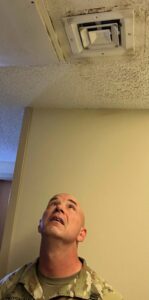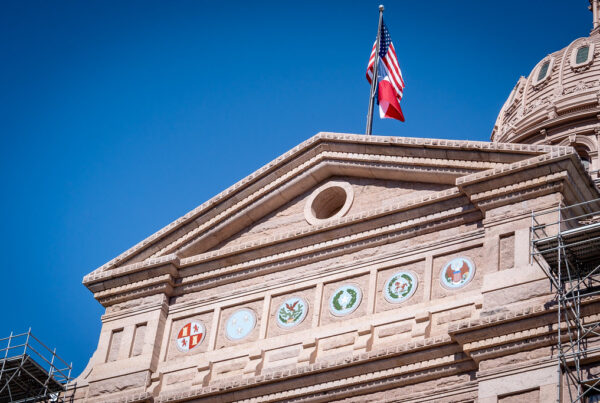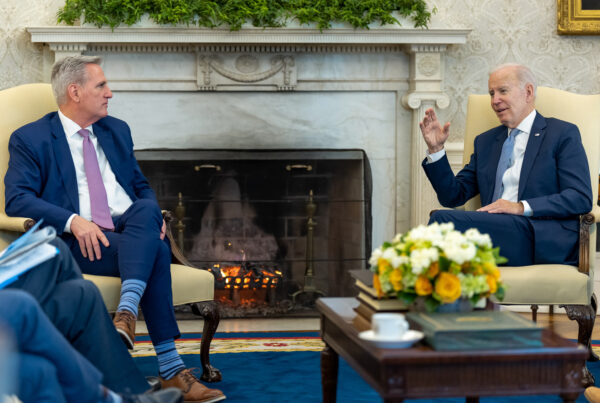From the American Homefront Project:
The Army is escalating one of its toughest – and oldest – battles. And it’s one that many homeowners can identify with: The fight against mold.
Army-ordered inspections of all barracks, office buildings, and childcare centers found mold in more than 2,100 locations. In response, leaders have implemented a systemic approach that makes mold prevention a basic part of being a soldier.
Regular inspections of barracks rooms are now teaching moments.
On a recent day at Fort Bragg, N.C., Sergeant Major David Cutshall of the 18th Field Artillery Brigade did a walk-through inspection of the apartment-like barracks suites of several of his soldiers.
The base, which will be renamed Fort Liberty in June, is not only the nation’s most populous Army base, but also is in a humid climate.
Each time Cutshall walked into a room, the first thing he did was look up.

David Cutshall, the command sergeant major of the 18th Field Artillery Brigade, examines a dirty vent in a Fort Bragg barracks room. It was dust rather than mold, and he told the soldiers who lived there to clean it and showed them where their air filter was located so they could replace it.
Jay Price / American Homefront
“See it? See what I’m talking about?” he said, as he pointed at tiny black spots – together, enough to maybe cover a dime – dotting a vent cover in the ceiling.
“Yes, Sergeant Major,” said the residents, Privates Second Class Aubrey Smith and Indie Ziegler.
“That’s just regular maintenance,” Cutshall continued. “In hot humid areas, mold in barracks tends to be a problem. It’s our responsibility as soldiers to keep it maintained.”
He told the young soldiers to use an Army smartphone app to submit a maintenance request, both for the mold on the vent and for deteriorating caulk in their bathtub. He warned another soldier who had opened a window that it’s okay to do that in the spring, but it could foster mold in the more humid summer months.
The push to make fighting mold a higher priority started last year, after serious mold issues forced more than a thousand Fort Bragg soldiers to relocate from a cluster of barracks. A dozen of those buildings are scheduled to be torn down. Along with mold problems on Georgia and Maryland bases, that triggered the Army-wide inspections.
Now the Army is doing more to enlist its nearly half a million soldiers in the fight against mold, which can cause health issues that vary greatly depending upon the amount of exposure and how sensitive someone is.
Lieutenant General Omar J. Jones leads Army Installation Management Command, which is responsible for maintaining thousands of buildings.
He said the first step after the inspections was to develop standards for defining problem mold and cleaning it up. His command leaned on recent guidelines developed by the Army Public Health Center.
“We’ve got a common standard for how we remediate it,” he said. “And then we apply that same standard when the team comes back in to inspect after remediation to make sure we are being consistent in how we are addressing this across all the installations.”
The next step was to do more to educate the soldiers and civilians who work in Army facilities.
“So if they see mold or have a concern, how do they tell someone, who do they tell to make sure that we can get the right experts there to help them?” he said.
Jones said the plan also includes training and certifying remediation and inspection teams on each base; tracking mold cases with sophisticated software to identify trends; and giving higher priority to mold reports. He said the standard is to respond to reports in less than 24 hours.
The problem the Army faces is common. One study estimated 47 percent of U.S. homes had substantial dampness or mold issues. Another found 100 percent had mold on some surfaces.
“It’s everywhere all the time,” said Philip Fairey of the University of Central Florida’s Solar Energy Center, an expert on mold issues in structures. “There are mold spores everywhere. Basically all they need is enough surface water activity to grow, and that’s often the case in buildings.”
How the spores get that moisture is what humans have to figure out and prevent. And it’s often complicated. The cause of moisture that triggers, say, serious mold inside walls, isn’t always obvious.
Another challenge is determining whether a particular mold problem is serious. For example, Fairey said mold in tiled bathrooms – which pops up a lot in the barracks – rarely is a major problem.
“It happens in every home with a tiled shower,” Fairey said. “Every single one, because there’s enough moisture there to support the growth of mold. So is that a problem or not? It’s not really a problem for me because a little bit of Clorox will fix it.”
But something like condensation on the inside of vinyl wall coverings could cause massive damage to a building and happen unseen.
For larger issues, like if mold covers more than 10 square feet or appears in porous materials or ventilation systems, the Army will bring in work crews.
Extreme cases of mold damage, like the Fort Bragg barracks that will be torn down, are rare. Base Housing Division Chief Steve Wykel said the buildings were relatively old, and mold was just one factor in the decision to demolish them.
He said one piece of faulty equipment triggered the mold issues in all them. They shared an HVAC system, and a leak under a parking lot prevented it from dehumidifying the air it was pumping into the buildings.
Jones, the Army facilities command leader, said older buildings were more likely to have mold issues in the recent wave of inspections. But geography was a bigger factor. By far, the most problems were on bases in the Southeast.
“So where you’ve got high heat and humidity particularly in the summer months,” Jones said.
And those summer months are coming. Wykel, the Fort Bragg housing official, said last year the base averaged 40 mold-related maintenance work orders per week for its 129 barracks buildings, which have about 9,000 bedrooms..
“As we start moving into the more humid months, I’m anxious to see is there a noticeable difference,” Wykel said. “Did it increase because there’s more awareness …. or does it reduce because we’ve educated them on the difference between what is mildew, what is mold, what is reportable, and what is cleanable by the soldier and the units themselves?”
This story was produced by the American Homefront Project, a public media collaboration that reports on American military life and veterans.















